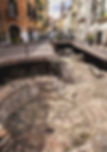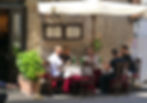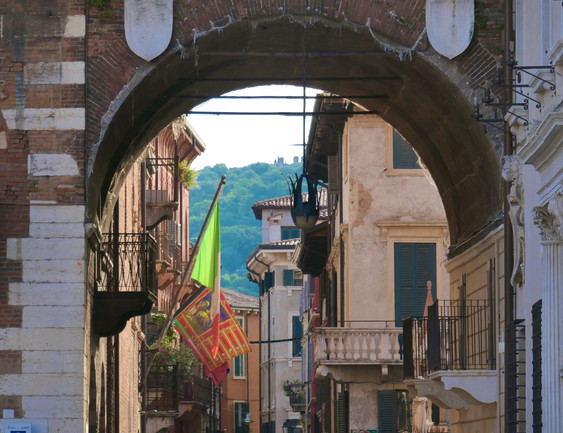Verona, Part 2
- Mike
- Jan 12, 2022
- 7 min read
Updated: Sep 26, 2024
Continuing from where we finished in Part 1, exit the Piazza dei Signori through the arch (above left photo) just to the right of the Palazzo Podestà and you will immediately be confronted by a strange sight for the middle of a city. Inside a large wrought iron cage are the elaborate outdoor tombs of the Lords of Verona from 700 years ago. Not something I was expecting the first time we visited Verona several years ago but part of what makes Italy so fascinating.

The della Scala family, whose members were known as Scaligeri, ruled Verona and most of mainland Veneto for about 125 years in the 13th and 14th centuries in what was undoubtedly the golden age for Verona as an independent city state. Surprisingly perhaps, their presence in this small central piazza survived all the turbulent centuries that followed and now of course the much feared Scaligeri in life have become a tourist attraction in death.
In many respects this small square is no different from the various famous and elaborate cimiteri monumentali around Italy, ie. cemeteries that have become open-air museums of funerary art as people have commissioned architects and artists to design special chapels and tombs for them instead of the standard cemetery consisting of rows of concrete vaults piled on top of each other. Many of the cimiteri monumentali in Italy are now quite famous and have become part of Italy's cultural heritage as well as being the final resting place for famous people, but none of them are in the center of cities as these tombs are in Verona.

Above the door to the adjacent Romanesque church of Santa Maria Antica is the tomb of Cangrande I, who died in 1329, and his sarcophagus is supported by stone dogs reflecting the meaning of his name in Italian.
There is an equestrian monument above his remains that is a replica, but the original is not far away at the museum in the Castelvecchio. The founder of the Scaligeri dynasty, Mastino, is also in one of the tombs here, having been assassinated nearby in 1277.
There is an interesting modern postscript to the story of Cangrande I, best known these days perhaps as the benefactor of Dante. During all of the successive centuries since 1329 there were suspicions of foul play associated with his sudden death at the age of 38 in Treviso, where he fell ill soon after conquering that city, dying a mere four days later.
Several years ago researchers from the University of Pisa, who have become famous for their medieval cold case work on the history of diseases, exhumed his body and found his mummified remains in good enough condition to obtain a fecal sample for analysis. This sample, together with an examination of his liver, showed fatally toxic concentrations of foxglove (digitalis) making it fairly certain that he was deliberately poisoned, which is perhaps why one of Cangrande's physicians was hanged by his successor soon after Cangrande's death.


On the way to the Duomo, the penultimate destination on this tour of Verona, you can pass through one of the ancient Roman gates into the city, the Porta Borsari. Originally called Porta Iovia after the temple of Jupiter that at one time was right next to it but now no longer exists, the inscription on the lower level describes nothing more exciting than various repairs attributed to Emperor Gallienus in 265 A.D. Built from local limestone, Porta Borsari was the main entrance into the city from the via Postumia.
The photograph above hopefully gives you some idea as to why it's worth getting up early so you can quietly take in the full majesty of something 2,000 years old without being jostled by idiots with selfie sticks who view Roman antiquity as just another opportunity to post a new picture of themselves on Instagram. The local Veronesi on the left hand side were up early for their coffee with the same thought in mind no doubt.
The Porta Leoni on the opposite side of the small centro storico is less impressive but it has the advantage of an open area of excavation adjacent to the gate which shows the original base of the circular tower below street level.

On our way to the Duomo, which is situated in an odd place at the apex of the river bend not far from the Ponte Pietra, we passed one of the most highly rated restaurants in Verona, the Antica Torretta, at midday where the waiters and kitchen staff were enjoying their early lunch at the best table outside, an hour before their customers start to arrive. We picked a different restaurant for dinner (see below) with a more traditional Veronese menu and much more reasonable prices for both food and wine.
The exterior of the Duomo is a little understated by the standard of many Italian cathedrals, in part perhaps due to its age. It was built in the 12th century and later modified with Gothic and Baroque additions over the successive centuries. It has a striped Romanesque exterior but there is a much more impressive frescoed interior (above) with stunning paintings everywhere.

On the outside, the two storied protruding portal is supported by a griffon on either side, which is a composite mythical creature with a lion's body and a bird's head, normally wingless. The same 12th century sculptor worked on the nearby Basilica di San Zeno but there he used lions at the base and added reliefs depicting the life of Theodoric the Great, the Ostrogoth king who was one of the last to rule all of Italy after the fall of the Western Roman Empire. He established his control over the Italian peninsula with a victory over the Germanic Odeacer at Verona in 489. It was Odeacer in fact who had a few years earlier brought an end to Ancient Rome when he deposed the child emperor Romulus Augustus.
While on the subject of churches in Verona, the Duomo has some real competition from Sant'Anastasia near Ponte Pietra. It's a rather plain and dull church from the outside, perhaps as a result of it being designed by Dominican friars, but it has an interior that is certainly bigger than the Duomo and may even be more grand so it's well worth a peek inside (below right).
The final stop on this walking tour, which seems to be taking longer to describe than it takes to actually walk, is the Castelvecchio. As the most evocative approach is from the western side, you should cross over the river at the nearby Ponte Garibaldi after visiting the Duomo and walk south along Lungadige Giacomo Matteotti.

This will bring you to the Ponte Scaligero, a famous and very distinctive old Verona bridge, painstakingly rebuilt with the original bricks that had to be fished out of the river after its complete destruction by the retreating German army in 1945.
Built as a fortress by the Scaligeri family in the mid 14th century it now houses an impressive art gallery of mostly medieval paintings and frescoes. The other art gallery of note in Verona is the Achille Forti Gallery of Modern Art in the Palazzo della Ragione. Modern art is a relative term so in Italy it includes everything from the 18th century onwards.

Always on the lookout for good restaurants that emphasize local dishes, our most memorable dinner on our last trip to Verona was at Trattoria Pane e Vino - Casa dell'Amarone, located in a less touristy part of the centro storico not far from the Duomo.

One glance at their menu shows how seriously they take traditional Veronesi dishes whether antipasti, primi piatti or secondi. We mentioned in our article on San Pietro in Cariano the fondness for meat in this part of Italy as well as their tradition of eating horse meat and the menu here reflects that.

They have the Pastissada de Caval dish on the menu which is one of the oldest and most traditional Veronese dishes, stewed for hours in copious amounts of local Valpolicella and supposedly dating back to Theodoric's famous battle in 489 when so many horses were slaughtered that they came up with this recipe. It's not really a summer dish however.
Verona is polenta and risotto country and the local pasta shape is bigoli which is a thicker type of spaghetti and very similar to pici in Tuscany. Lake fish from nearby Lago di Garda feature on many menus in Verona and you will also quite often see the famous Venetian antipasto cicchetti (below left). There's also a delicious local sausage called Cotechino that is typically accompanied by lentils but here they had an interesting variation, serving a very generous portion of cotechino on Pearà, a sauce made from local Veronese bread and pepper (below right).
There was a fabulous quiet atmosphere in this restaurant and the service was attentive but discreet. Both the food quality and presentation were of the highest order and the prices at Pane e Vino were very reasonable for such a high quality restaurant in the middle of a city in the north of Italy.

(Which serves also to emphasize how much of a bargain the much lower cost of a dinner was only 9 miles away in San Pietro in Cariano).
Also, we have nothing but the highest praise for the sommelier here at Pane e Vino who listened carefully to our reservations about the style of many Valpolicella Ripasso wines, put his neck on the line and brought us a wine we didn't know but at six years of age was at it's absolute peak.
He clearly knew his stuff because the Musella 2015 Valpolicella Ripasso Superiore was certainly among the finest Ripasso wines we've ever had, with none of the overdone flavors often present in this category of wine. In fact on our return to Lucca when I had a chance to do some research on the Musella 2015, I found a review from a wine critic who is generally quite reliable and who ended his review with the comment "if it has to be Ripasso, then only this". My sentiments exactly.
Furthermore the price of this wine in Pane e Vino was 25 euros, exactly the same price as the cheapest retail price I could find anywhere in Italy, so we walked out of one of the best restaurants in Verona with very full stomachs and a total bill of only 93 euros. Excellent value.
Finally, the first thing you should do on arrival in Verona is buy a 'Verona Card' or buy it on-line beforehand. It will save you money if you plan to visit many or all the places we've described but more importantly it will save you time queuing.




















